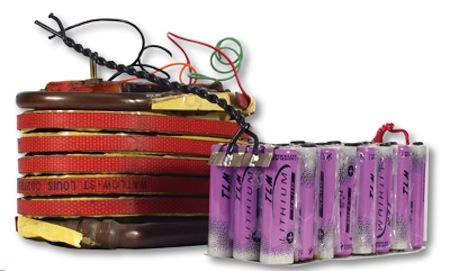While the battery chemistries used to power single-use military and aerospace applications remained virtually unchanged for decades, technological advancements have pushed legacy batteries to their limit in terms of supporting advanced product designs for avionics, navigation systems, ordinance fuses, missile systems, GPS tracking and emergency/safety devices, shipboard, and oceanographic devices.
Recognizing that antiquated battery technologies would hold back new product development, the US Department of Defense identified the “critical need” for a new generation of high-power, long-life batteries for single-use applications. From this challenge, a new battery technology has emerged that represents a viable alternative to legacy battery technologies.

Twenty-four lithium metal oxide cells are 30-percent smaller and 75-percent lighter with 3.5 times more energy density than an equivalent silver-zinc battery.
(Source: Tadiran Batteries)
(Source: Tadiran Batteries)
Reserve and thermal batteries store the electrolyte separately from other active ingredients, which keeps it inert until a pyrotechnic device initiates a chemical reaction. The most popular type of reserve battery is the thermal battery, which utilizes a metallic salt electrolyte that is inert and non-conducting in its solid state at ambient temperatures. A squib delivers a pyrotechnic charge that causes the electrolyte to become molten at 400C to 700C, thus energizing the cell to deliver short-term continuous current from a few watts to several kilowatts depending upon battery size and chemistry.
Advantages of thermal battery design include ruggedness, safety, reliability, and long shelf life. Limitations include an inability to test the cell without fully depleting it, delayed battery activation, and the need for insulation layers to keep the molten electrolyte at a steady temperature, and to protect surrounding components from heat-related damage.
No comments:
Post a Comment